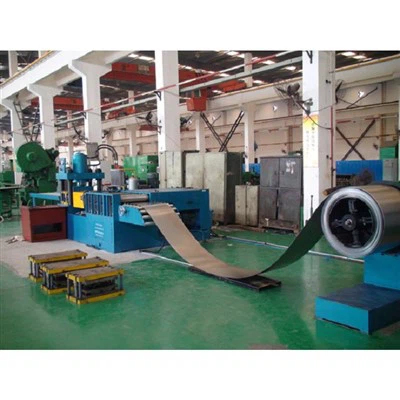The transformer radiator rolling machine is equipment used for processing transformer plate-type radiators. The following introduces it from aspects such as working principles, structural composition, characteristics, and applications:
Rolling Forming Principle
Through the concave-convex coordination between the upper and lower forming pressure rollers, the fed steel plate workpiece is rolled, causing the steel plate to undergo plastic deformation under pressure to form required shapes such as oil channel grooves.
Feeding Principle
The feeding mechanism is typically composed of upper and lower pressure rollers, which form a clamping force on the steel plate. The motor drives the upper and lower pressure rollers to rotate, conveying the steel plate to the rolling forming pressure roller set at the rear end.
Length Measurement Principle
A rotary length signal generator is used, whose measuring end presses against the surface of the workpiece in front of the rolling forming pressure roller set. As the workpiece moves, the measuring end of the generator rotates accordingly. Internal sensors convert information such as the rotation angle into electrical signals, which are then calculated to obtain the workpiece's length, achieving precise measurement of the radiator workpiece's length.
Composed of multiple sets of upper and lower forming pressure rollers, which coordinate with each other via concave-convex profiles. Different rolling forming pressure roller sets are selected according to the specifications of radiators being processed. There is no need to frequently replace the upper and lower forming pressure rollers-only the molds of the stamping press need to be changed, significantly improving production efficiency.
Feeding Mechanism
Includes upper pressure rollers, lower pressure rollers, and a transition section. The transition section is equipped with unpowered rollers to guide the steel plate smoothly into the feeding mechanism, while the upper and lower pressure rollers clamp and convey the steel plate.
Stamping Press
Located at the output end of the rolling forming pressure roller set, the stamping press performs stamping and shearing on the workpiece with oil channel grooves as it passes through. It cuts the workpiece and presses out the head and tail grooves to form a single complete radiator plate.
Positioning Rollers
Installed at the front end of the stamping press, they ensure the workpiece remains stable before entering the press, guaranteeing the accuracy of stamping and shearing.
Rotary Length Signal Generator
Mounted on a bracket, its measuring end presses against the surface of the workpiece in front of the rolling forming pressure roller set, used for precisely measuring the length of radiator workpieces.
Drive Motor and Gearbox
A drive motor is installed on the machine base. The upper pressure rollers of the feeding mechanism and one end of the upper forming pressure rollers are connected to the gearbox. The drive motor drives the upper pressure rollers and upper forming pressure rollers to rotate via the gearbox, providing power for feeding and rolling forming.
Guiding Mechanism
Guiding mechanisms are arranged on both sides of the machine base along the conveying channel, consisting of a lower base plate and pressure wheels on the base plate. The upper and lower surfaces of both sides of the workpiece are positioned between the lower base plate and pressure wheels to guide the workpiece and prevent deviation during conveying.
High-Efficiency Production
Using rolling forming technology, it can continuously process steel plates, significantly improving production efficiency compared to traditional single-piece stamping forming technology. Additionally, increasing the rolling speed further boosts output.
01
Cost Reduction
When changing plate length specifications, there is no need to replace molds, saving substantial mold costs and time for mold replacement and debugging, thus reducing production costs and labor intensity.
02
High Precision
Equipped with a rotary length signal generator, it can accurately calculate the center distance of radiator plates with a precision of ±0.2mm, ensuring product dimension accuracy and improving product quality.
03
Advanced Technology
Adopting cold rolling and stamping composite forming technology solves the problem that large or extra-large transformer radiators cannot be achieved by pure cold stamping. The longer the plate length, the more prominent the advantages of rolling forming.
04
Wide Application Range
Capable of processing transformer radiators of different specifications, it meets the heat dissipation requirements of various power transformers, greatly enriching product specifications and application scenarios.
05
Mainly used in the power transformer manufacturing industry to produce various types and specifications of transformer plate-type radiators. It meets the heat dissipation requirements of power transformers with different voltage levels and capacities, ensuring that transformers can effectively dissipate heat during operation and maintain normal operation and service life.
https://www.czhcautomated.com/
